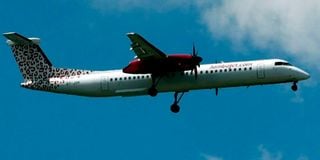Premium
Jambojet: Why we control half of Kenya’s aviation pie

Jambojet plane pictured as it flew to Jomo Kenyatta International Airport in Nairobi on November 24, 2020.
When President Uhuru Kenyatta placed five counties under lockdown on March 26 this year to contain spread of Covid-19, many cross-county businesses were forced to suspend operations.
Caught with pants down, and with many of their aircraft within Nairobi, airlines cancelled flights but not Jambojet.
“The announcement caught us by surprise, it was around afternoon but within an hour, we had quickly arranged a meeting and agreed to fly two of our six aircraft to Mombasa with pilots, cabin crew, maintenance team and everything that was required,” said Jambojet managing director Karanja Ndegwa last week.
The two planes would set base in Mombasa from where they would operate around counties that were spared the lockdown.
And with that quick decision, Mr Ndegwa says the airline saved itself 15 per cent of the total losses it would have incurred over the period.
“We kept our operations going, we kept the equipment running. Since it was around the Easter season, all flights operated in full capacity and the amount of revenues the two aircraft generated saved us at least 15 per cent of losses we would have incurred had all the aircraft been grounded,” he said.
Low cost carrier
This is the agility the local low cost carrier says has given it an edge over other airlines operating within the local market, clinching about 45 per cent of Kenya’s aviation market share.
With six local destinations currently, the low cost carrier says it has lifted about 4.3 million passengers since coming to the market.
“For the seven years that we have operated, four years were profitable. The loss making years were the year we began operations, the election year in 2017 because of the repeat election and obviously 2020 because of the Covid-19 pandemic,” Mr Ndegwa said.
As the airline was penetrating the market, so were its operations and profits growing and by 2019, it lifted over 700,000 passengers, making the highest profit of Sh121 million.
“The projection was that by 2021, we would be lifting about a million passengers per year. This has come down because of the reduced operations. Currently we are not fully operating because of the curfew and we are trying also to manage our costs so we only operate when it makes economic sense,” Mr Ndegwa said, observing that the airline is currently operating at 84 percent capacity.
Operating at one of the most difficult times for players in the airline industry, the Jambojet MD says working at low costs and creating a niche has been its greatest saviour, at a time when many airlines are closing down and others making losses in billions of shillings.
He says its reliability has also served to save it at these difficult times, seeing it increase its market share from 36 per cent by 2019, to the current 45 per cent.
Last year, the airline for the first time since the 2017 election year made losses, when its costs exceeded revenues by about 10 per cent. Mr Ndegwa says they are yet to recover.
Goma flights
“For us to get back to the levels we were operating in 2019, that will be around 2023. If we get back to that in 2022, we will be lucky,” Mr Ndegwa says, noting that being an election year, 2022 is expected to record low operations. But to cover for that and minimise cases of costs going up, the airline is in an expansion drive to venture into new routes, particularly out of Kenya.
On Friday this week, the airline will be commissioning flights to Goma, DRC as it targets to capture business travellers whose goods land at the Mombasa port.
Mr Ndegwa says research by the airline has revealed that Goma has been underserved, despite dealing with Nairobi even more than Kinshasa, the capital of DRC.
“The people of Goma mostly use Kigali and Addis Ababa to connect to the world and now we want to make Nairobi an option. Besides, there are UN offices in the town and a lot of movement happen between officials in Nairobi and the town,” he adds.
The airline says only by venturing into the underserved markets and operating with agility by avoiding red tape that chase away customers, can airlines survive in today’s tough market.
It adds that it has automated most of its services to have passengers access services digitally, as a way of cutting costs they would instead incur by employing many staff.





